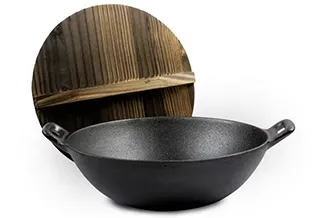
how to choose cast iron skillet
How to Choose a Cast Iron Skillet A Comprehensive Guide
Cast iron skillets are beloved kitchen staples celebrated for their durability, versatility, and unique cooking properties. Whether you're a novice cook or an experienced chef, choosing the right cast iron skillet can significantly enhance your culinary experience. Here’s a comprehensive guide to help you select the perfect cast iron skillet.
1. Understand Your Cooking Needs
Before diving into the world of cast iron skillets, consider what you will be using it for. Cast iron skillets are ideal for frying, sautéing, baking, and even roasting. If you plan to use it for various cooking methods, a versatile skillet with high sides and a wide diameter is essential. For specific purposes, like baking cornbread, consider a skillet that can withstand oven temperatures and has the right shape.
2. Size Matters
Cast iron skillets come in various sizes, typically ranging from 6 to 15 inches. A 10- or 12-inch skillet is often the most versatile option for most households, comfortably serving multiple portions without overcrowding. If you frequently cook for a large family or enjoy hosting gatherings, consider investing in a larger skillet. Conversely, smaller skillets can be great for individual meals or side dishes.
3. Weight and Handle Design
Cast iron skillets are heavy by nature, which contributes to their heat retention and even cooking. However, if you're not used to handling heavy cookware, it’s important to choose a skillet that feels comfortable for you. Look for skillets with ergonomic handles that provide a secure grip. Some models even feature helper handles for better lifting and maneuvering.
4. Preseasoning vs. Unseasoned
Many cast iron skillets come preseasoned, meaning they have been treated with oil to create a non-stick surface. This can save time and effort, making it easier to start cooking right away. On the other hand, some skillets are sold unseasoned, allowing you to add your own layer of seasoning according to your preference. If you choose an unseasoned skillet, be prepared to invest time in the initial seasoning process for optimal results.
how to choose cast iron skillet

5. Quality and Brand Reputation
Not all cast iron skillets are created equal. When selecting one, consider reputable brands known for their craftsmanship and durability. Brands like Lodge and Staub are well-regarded in the market. Reading customer reviews can also provide insights into the skillet’s performance and longevity.
6. Versatility and Compatibility
Cast iron skillets are compatible with most heat sources, including stovetops, ovens, grills, and even campfires. However, if you have specific cooking appliances like induction cooktops, ensure the skillet you choose is compatible. Consider whether the skillet design suits your cooking style; some may have features like poured spouts for easier draining or additional surfaces for grilling or baking.
7. Price Point
Cast iron skillets can vary significantly in price, generally ranging from $20 to over $200. While it can be tempting to opt for the cheapest option, consider investing in a high-quality skillet that will last for generations. A durable skillet is a long-term investment that pays off with better cooking results and longevity.
8. Maintenance and Care
All cast iron skillets require maintenance to preserve their seasoning and prevent rust. Be prepared to dedicate time to cleaning and re-seasoning as needed. Choose a skillet that fits your willingness to properly care for it, ensuring its durability and performance over the years.
9. Conclusion
A cast iron skillet is an indispensable tool in any kitchen, and choosing the right one can enhance your cooking experience. By considering your culinary needs, selecting the appropriate size, and investing in quality craftsmanship, you can find a skillet that not only meets your cooking requirements but also becomes a cherished item passed down through generations. With the right care, your cast iron skillet will be a reliable companion in your culinary adventures for years to come. Happy cooking!
-
Extra Large Round Cast Iron Griddle - Heavy Duty Griddle Plate for Even Heating & Versatile CookingNewsJun.10,2025
-
Top Brands of Cast Iron Cookware Durable & Versatile Cast Iron Skillet BrandsNewsJun.10,2025
-
Enamel Coated Cast Iron Pot Durable, Non-Stick & Even Heat CookingNewsMay.30,2025
-
2 Quart Dutch Oven Durable Cast Iron, Even Heating & VersatileNewsMay.30,2025
-
Best Chinese Wok Price Authentic Iron Pans, Fast Shipping & DealsNewsMay.29,2025
-
Non-Stick Cast Iron Skillet with Lid Durable & Easy-Clean PanNewsMay.29,2025


